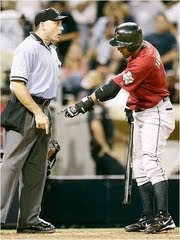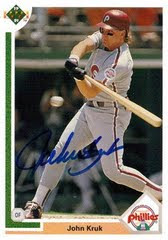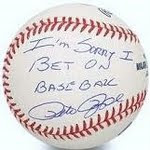 Converting catchers into pitchers is nothing new or unique. Most recently, it has happened to Jason Motte and Carlos Marmol. Catchers, at least defensively capable ones, generally have strong arms, so such a conversion makes sense. Edwin Jackson, taken in the 6th round of the 2001 amateur draft, was drafted by the Dodgers as a catcher but converted into a catcher given his strong arm. The results were mixed. On the plus, Jackson could throw 95+ MPH and flashed above average strikeout ability. However, given his lack of pitching experience, he Jackson exhibited little control (7.8 BB/9 during his first 22 IP stint in 2001). Over his first few minor league seasons, Jackson's control rate seemed to"normalize" around a much more acceptable, though still below average, 4.0 BB/9 range. Jackson was clearly a work in progress, but quickly rose to the majors in 2003 to work out of the pen. Early on, Jackson was given the title of a "can't miss" prospect, but struggled mightily in 2004 and 2005 (largely due to BB/9 rates of 4.01 and 5.43, respectively) and the Dodgers sold low, shipping him off to the Devil Rays for pitchers Danys Baez and Lance Carter, neither of whom actually contributed anything to the team.
Converting catchers into pitchers is nothing new or unique. Most recently, it has happened to Jason Motte and Carlos Marmol. Catchers, at least defensively capable ones, generally have strong arms, so such a conversion makes sense. Edwin Jackson, taken in the 6th round of the 2001 amateur draft, was drafted by the Dodgers as a catcher but converted into a catcher given his strong arm. The results were mixed. On the plus, Jackson could throw 95+ MPH and flashed above average strikeout ability. However, given his lack of pitching experience, he Jackson exhibited little control (7.8 BB/9 during his first 22 IP stint in 2001). Over his first few minor league seasons, Jackson's control rate seemed to"normalize" around a much more acceptable, though still below average, 4.0 BB/9 range. Jackson was clearly a work in progress, but quickly rose to the majors in 2003 to work out of the pen. Early on, Jackson was given the title of a "can't miss" prospect, but struggled mightily in 2004 and 2005 (largely due to BB/9 rates of 4.01 and 5.43, respectively) and the Dodgers sold low, shipping him off to the Devil Rays for pitchers Danys Baez and Lance Carter, neither of whom actually contributed anything to the team. On the Devil Rays, Jackson was converted into a starter. He spent the majority of the 2006 season in the minors, where he continued to show control problems (4.3 BB/9) mixed reasons for hope (strong fastball, nasty slider, 8.1 K/9). Regardless of his persistent control issues, Jackson was promoted as a full time starter to the Devil Rays in 2007, where, unsurprisingly, his control problems (4.92 BB/9) continued to hinder him (5.76 ERA, 4.95 xFIP) in a Manny Parra-like way.
On the Devil Rays, Jackson was converted into a starter. He spent the majority of the 2006 season in the minors, where he continued to show control problems (4.3 BB/9) mixed reasons for hope (strong fastball, nasty slider, 8.1 K/9). Regardless of his persistent control issues, Jackson was promoted as a full time starter to the Devil Rays in 2007, where, unsurprisingly, his control problems (4.92 BB/9) continued to hinder him (5.76 ERA, 4.95 xFIP) in a Manny Parra-like way.But then something happened. The Devil Rays dropped the "Devil" from their name and Edwin Jackson stopped handing out free passes left and right. Though the strikeout rate plummeted 26% to a mere 5.9 K/9 (below league average), the fastball remained around 94 MPH, the slider became eight times more effective (from +0.35 runs prevented per 100 times thrown to +2.87 runs per 100 pitches), and most importantly, the BB/9 rate fell to a career best 3.78 (still below league average, but much improved over the 5.21 career BB/9 he has through the 2007 season). The results less than spectacular (4.42 ERA, 5.03 xFIP), but there were reasons not to doubt Edwin Jackson as a complete bust going forward. The Rays utilized the opportunity of Jackson's relatively "strong" 2008 season to acquire Matt Joyce, another promising talent without the expected results, from the Tigers in exchange.
With two seasons of improving walk rates and a seemingly seasoned slider at his disposal, 2009 was an important season for Edwin Jackson. He was set to become arbitration eligible for the first time after the season and thus his future -- that is to say his end of season payday and status as a possible non-tender -- seemed to bank on whether or not he continued to make strikes in his control. I, like many others, was quite skeptical of Jackson for 2009. On a podcast we did in the early summer, I ranted for minutes about the plethora of reasons I did not believe in Edwin Jackson. On my fantasy team, I flipped Edwin Jackson early on, thinking I was "selling high," for Scott Baker, of whom I thought I was buying low. I am willing to admit when I am wrong and wrong I was...sort of.
 True, Edwin Jackson ended the season with a valuable 3.62 ERA and 1.26 WHIP and shaved his walk rate down to a better-than-league-average 2.94 per nine mark. Jackson also rebounded somewhat in the strikeouts category (6.77 K/9). The improved control and overall results were nice, but the seasonal splits (2.57 ERA in the first half of the season, 5.07 ERA thereafter) and peripheral stats (4.39 xFIP) simply do not accord. Looking at the splits, one also finds a control disparity. Whereas Edwin Jackson issued a mere 37 walks through his first 121.2 IP (2.66 BB/9), he walked the same amount through his final 92.1 IP (3.61 BB/9).
True, Edwin Jackson ended the season with a valuable 3.62 ERA and 1.26 WHIP and shaved his walk rate down to a better-than-league-average 2.94 per nine mark. Jackson also rebounded somewhat in the strikeouts category (6.77 K/9). The improved control and overall results were nice, but the seasonal splits (2.57 ERA in the first half of the season, 5.07 ERA thereafter) and peripheral stats (4.39 xFIP) simply do not accord. Looking at the splits, one also finds a control disparity. Whereas Edwin Jackson issued a mere 37 walks through his first 121.2 IP (2.66 BB/9), he walked the same amount through his final 92.1 IP (3.61 BB/9).Jackson definitely showed signs of improvement in 2009, but he was not nearly "as good" of a pitcher as his season totals seem to indicate. There is definitely room and hope for improvement, but at age 27, what more can we expect from Edwin Jackson? Will he continue to improve the walk rate in 2010, a la the first half of 2009, or will he simply make modest strides?
Given his age, I lean towards the latter. Jackson has sort of been learning to pitch as he goes. Some might say he does not exactly "pitch" as much as he "throws." Perhaps Jackson, having never logged even 185 IP before 2009, simply burned out towards the end of the season. There is certainly evidence of this as his strikeout rate, which floated around the 7.1-7.7 range between May and July, dropped off in August and September. For the sake of simplicity, I am going to use Jackson's 2009 xFIP of 4.39 and his 2009 ratios as the baseline for my 2010 projection and urge that you adjust the final numbers up or down based on whether you perceive Jackson's strikeout and walk rates to improve or regress going forward.
First things first, we need to adjust for Jackson's change in leagues. Using 5 year data from 2004 to 2008, The Hardball Times found that a pitcher who switched over from the AL to the NL primarily saw changes in their K/9 rate (+0.57) and ERA (-0.41). Accounting for these factors and holding Jackson's 2009 rates constant, this would give him a K/9 of 7.36 and an ERA of 3.98.
Next, we need an innings total for 2010. The projection systems hosted on Fangraphs have him pegged at somewhere between 178 IP (CHONE) and 218 IP (Bill James). Given Arizona's relatively poor chances of competing in 2010, I am going to assume that the Diamondbacks are not going to unnecessarily abuse Edwin Jackson's arm like the Tigers did last season (Jackson was third overall in total Pitcher Abuse Points). Thus, 200 IP seems reasonable -- especially if Brandon Webb starts the season on the DL and Jackson ends up the #2 pitcher in the rotation by default.
With 200 IP, Jackson's baseline of runs allowed would be 88.45. From here, we need to accord for park factors. According to Baseball Reference's multi-year park factor data, Chase Field has inflated run scoring by 9%, while Comerica Park has inflated run scoring by 3%. Accounting for the park change, Jackson's runs allowed total then increases to 93.60 per 200 IP.
After adjusting for park factor and league change, we must finally accord for defensive modifications. In 2009, the Diamondbacks prevented 21.6 Fielding Runs Above Replacement (FRAR). Over the offseason, Arizona added both Kelly Johnson (+5 FRAR) and Adam LaRoche (-3 FRAR) to the team team (projected defense courtesy of CHONE). Keeping the 2009 Diamondbacks defense constant and adding the additional +2 FRAR of Johnson and LaRoche to the team, the Diamondbacks would have a cumulative FRAR in +23.6. If you think the team's defense would change up or down compared to 2009, adjust accordingly. The average major league team played 1442 innings of defense last season, though the Diamondbacks played 1447.2 last year. I am going to use the 1442 innings as the baseline for this forecast; if you think the Diamondbacks play more or less, adjust accordingly. With a FRAR of +23.6 over 1442 IP, the Diamondbacks would prevent +0.016 runs per inning of play compared to the league average defensive posture. Over 200 innings, that would be 3.27 runs prevented. Subtracting this from Jackson's league and park adjusted runs allowed forecast and we get an estimated 90.33 runs allowed by Jackson in 2010.
Thus, over 200 IP, Edwin Jackson would have an ERA of 4.06 with 164 strikeouts (7.36 K/9) to boot. Jackson had a quality 1.26 WHIP last season, but a career mark of 1.51. Last season was the first time since 2004 that Jackson's WHIP has been under 1.50. I'm pegging Jackson for a 1.40 mark as the baseline for 2010. Bill James puts his WHIP projection at 1.50, while CHONE has theirs at 1.42.
According to Roto Authority's "what it takes to win" estimates for 2010, the average starting pitcher on your squad will should accumulate a 3.78 ERA, 181 K's, 1.27 WHIP and 13.67 Wins. Jackson does not seem particularly pegged for any of those numbers, but should provide value as one's last SP or two on the roster, provided you draft a few strong pitchers with projections ahead of the "what it takes to win" curve. As of 3/19/10, Edwin Jackson has an ADP of 168 on Mock Draft Central (you will need a free account to view this data). He is being drafting within the starting pitching company of John Danks (160), Ryan Dempster (161), Carlos Zambrano (166), David Price (172), Scott Kazmir (173), Neftali Feliz (174), Ted Lilly (179) and Gavin Floyd (182). Most of this players have higher upsides and lower downsides than Edwin Jackson, though Zambrano, Price, Kazmir and Floyd will all likely kill your WHIP just as much as Jackson. Can't exactly call Jackson a value pick here; he seems to be more of a brand name than value play at pick #168. Yahoo has him ranked even higher at #137 (which is baffling, considering they rank the Dirty Scherz at #261). ESPN had him ranked at #142 last time I updated my draft comparison rankings.
Conclusion: While Edwin Jackson may provide some relevant fantasy value (4.06 ERA, 7.36 K/9) in 2010, it will be as a back end of your fantasy rotation kind of guy given his below "what it takes to win" projected statistics and WHIP-killer ways. His relatively high ADP and risky downside make him a guy to avoid unless he falls acceptably late in the draft. If you simply must own Edwin Jackson, you will probably get a better value on him in auction leagues than draft leagues. No stamp of approval here.






